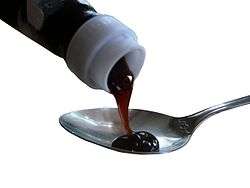Oyster sauce
| Oyster sauce | |||||||||||||
 | |||||||||||||
| Traditional Chinese | 蠔油 | ||||||||||||
|---|---|---|---|---|---|---|---|---|---|---|---|---|---|
| Simplified Chinese | 蚝油 | ||||||||||||
| Literal meaning | oyster oil/liquid | ||||||||||||
| |||||||||||||
| Alternative Chinese name | |||||||||||||
| Traditional Chinese | 蚵油 | ||||||||||||
| |||||||||||||
Oyster sauce describes a number of sauces made by cooking oysters. The most common in modern use is a viscous dark brown condiment made from sugar, salt and water thickened with cornstarch, flavoured with a little oyster essence or extract.[1][2][3] Some versions may be darkened with caramel, though high quality oyster sauce is naturally dark.[4] It is commonly used in Cantonese, Thai, Vietnamese and Khmer cuisine.
Development
Traditionally, oyster sauce is made by slowly simmering oysters in water until the juices caramelise into a thick, brown, intensely flavourful sauce. Today, many shortcuts have been made to create a similar flavour more quickly and at reduced cost. Oyster sauces today are usually made with a base of sugar and salt and thickened with corn starch. Oyster extracts or essences are then used to give flavour to the base sauce. Other ingredients, such as soy sauce and MSG may also be added to deepen the flavour and add colour. The quality of the oyster sauce will greatly affect the flavour.[5]
Culinary use
Oyster sauce adds a savory flavour to many dishes, making it an ideal choice for flavouring meat and vegetables. The sauce is a staple for much Chinese family-style cooking. It is commonly used in noodle stir-fries, such as chow mein. It is also found in popular Chinese-American dishes such as beef with stir-fried vegetables. Oyster sauce can also be used as a topping for some dishes.
Dishes that may use oyster sauce include Crab in oyster sauce, Kai-lan, Buddha's delight, Hainanese chicken rice, Cashew chicken, Lo mein, Cha siu baau, Yum cha, Har gow, Kai yat sai, Wonton noodles, and Daikon cake.
Varieties
"True" oyster sauce of good quality should be made by condensing oyster extracts, the white broth produced by boiling oysters in water. This opaque broth, similar to the colour of clam juice found in supermarkets, is then reduced until a desired viscosity has been reached and the liquid has caramelized to a brown colour.[6] No other additives, not even salt, should be added to the sauce, since the oysters should provide all the savoury flavour. However, this method is prohibitively expensive.
Many modern oyster sauces are thickened with cornstarch, flavoured with oyster essence or extract[2][7] and darkened with caramel.[4]
Vegetarian oyster sauce
Vegetarian oyster sauce prepared from mushrooms, often oyster mushrooms or shiitake mushrooms, is also popular and generally lower in price. It may contain more taste enhancers if less mushroom extract is used to reduce costs.
Non-MSG oyster sauce
Most of the oyster sauces available on the market contain added monosodium glutamate (MSG). In recent years MSG-free varieties can also be found.[8] The taste of MSG and non-MSG variants is similar as oyster sauce naturally contains large amounts of glutamate.
European oyster sauce
In 19th century French and English cooking, "oyster sauce" referred to a variant of sauce blanche flavoured with oysters, using a base of milk and melted butter rather than purely reducing the oysters by cooking.[9][10] The white sauce version was moistened with cream, whereas in brown oyster sauce, the cream was replaced with gravy.[11] Common recipes using the sauce included "Steak and oyster sauce", documented as early as 1806,[12][13][14][15] and "Cod and oyster sauce".[16] This sauce was still being eaten in Australia in the 1970s.
Health
In 2001 the United Kingdom Food Standards Agency found in tests of various oyster sauces and soy sauces that some 22% of samples contained a chemical called 3-MCPD (3-monochloropropane-1,2-diol) at levels considerably higher than those deemed safe by the European Union. About two-thirds of these samples also contained a second chemical called 1,3-DCP (1,3-dichloropropane-2-ol) which experts advise should not be present at any levels in food. Both chemicals have the potential to cause cancer and the Agency recommended that the affected products be withdrawn from shelves and avoided.[17][18]
The joint Australia New Zealand Food Authority (ANZFA) said it had taken emergency action to amend its food standards code to set a limit for 3-MCPD in soy sauce of 0.02 milligrams per kilogram, in line with European Commission standards which came into force in the EU in April 2002.
Britain's Food Standards Agency (FSA) singled out brands and products imported from Thailand, China, Hong Kong and Taiwan. Brands named in the British warning include Golden Mountain, King Imperial, Pearl River Bridge, Jammy Chai, Lee Kum Kee, Golden Mark, Kimlan, Golden Swan, Sinsin, Tung Chun and Wanjasham soy sauce.
In July 2001, the FSA issued another statement clearing Lee Kum Kee's name after the company produced laboratory certificates from accredited, reputable laboratories. These certificates show that Lee Kum Kee products now comply with the proposed EU limit for 3-MCPD.
See also
References
- ↑ Wing Yip Oyster Sauce Ingredient List:1.3% oyster essence
- 1 2 The Times, 22 January 1981; Cook Accidentally on purpose
- ↑ BBC.co.uk [http://webcache.googleusercontent.com/search?q=cache:TvC0 hpsc340J:www.bbc.co.uk/food/glossary/e.shtml%3Fessence_or_extract+extract+essence&cd=1&hl=en&ct=clnk&gl=uk Essence or extract]
- 1 2 BigOven Food DictionaryOyster sauce
- ↑ Moncel, Bethany. "What is Oyster Sauce?". About.com. Retrieved 15 September 2013.
- ↑
- ↑ [http://webcache.googleusercontent.com/search?q=cache:TvC0 hpsc340J:www.bbc.co.uk/food/glossary/e.shtml%3Fessence_or_extract+extract+essence&cd=1&hl=en&ct=clnk&gl=uk "Essence or extract"].
- ↑ "bbc.co.uk".
- ↑ Mrs Beeton's Household Management, recipe 492 "Oyster Sauce", p. 224 (1861).
- ↑ Ude, Louis Eustache. The French Cook, p.293, Publisher Carey, Lea & Carey, 1829.
- ↑ Charles Elmé Francatelli The modern cook T.B. Peterson and Brothers, 1846
- ↑ The Ipswich Journal; 4 January 1806; Friday's Post
- ↑ The Times, 17 August 1815; Mendicity
- ↑ The Times, 30 March 1831 Police
- ↑ The Times, 22 October 1835 "On Monday afternoon..."
- ↑ "Fashions for August" Liverpool Mercury 9 August 1833
- ↑ "Food.gov.uk press release soysauce".
- ↑ "Chart with five mentions of affected oyster sauces".